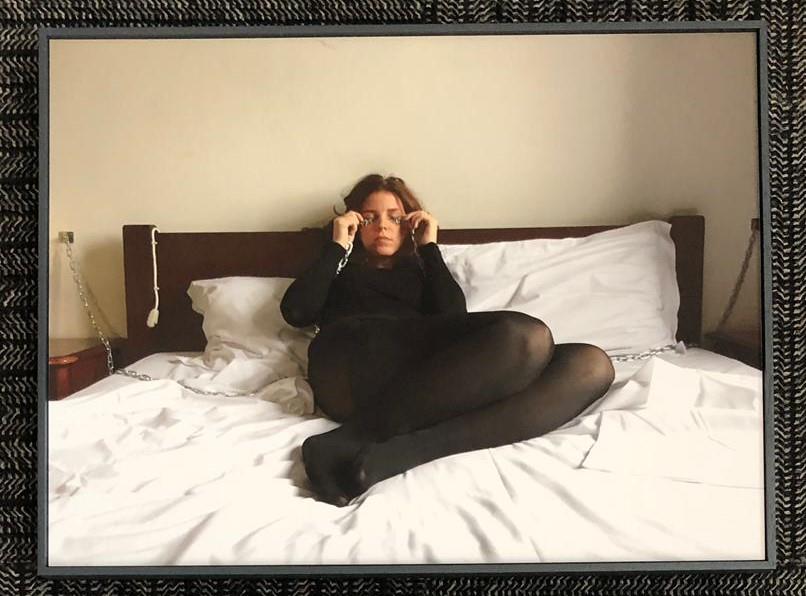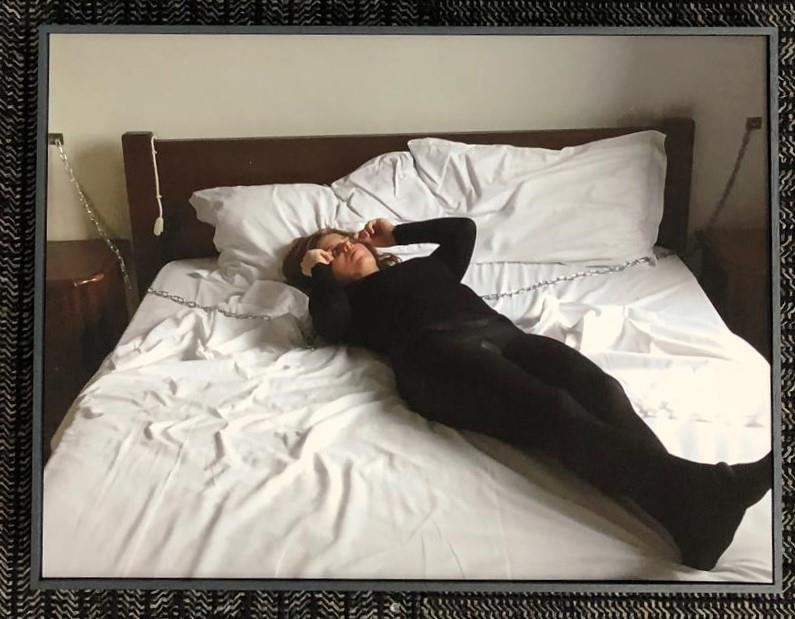- TitleBaby dull
- Author Silvia Giambrone
- Year 2018
- Classification Photograph
- Dimensions Height: 40,50 cm Width: 30,50 cm
- Edition 1/3 + A.P.
- Medium Print on Fine Art paper
Description
Silvia Giambrone's 2018 photographic diptych is consistent with her poetics, which is defined by a critical examination of power dynamics, the female body as a place of conflict, and oppressive and resistive dynamics. Let's examine it more closely.
A woman is seen in the two images resting on a bed. She appears to be in a state of psychological and physical restraint and is dressed in a form-fitting black outfit. Two components are especially important:
The figure is restrained by chains that are fastened to the bed, which is an obvious representation of confinement, oppression, or imprisonment. The fact that the shackles don't seem to actually apply physical force, however, indicates that the constraint is also symbolic or psychological.The woman appears to massage her face or cover her eyes with her hands in both pictures, which could be an attempt at denial or an expression of pain or displeasure.
The body and things are highlighted by the simple background, which consists of bare walls, a white bed, and soft natural light. Here, the bed—typically a space for intimacy—becomes a scene of struggle, expressing tension and uneasiness.
A powerful symbolic contrast is produced by the use of black and white (white sheets and dark clothing). Black could conjure oppression or inner darkness, whereas white could conjure purity or vulnerability.
Giambrone examines the issue of psychological as well as physical domestic abuse. The chains stand for the unseen limitations on women's freedom that are frequently connected to violent relationships or socially prescribed duties. The bed, which alludes to the home environment, emphasizes how these relationships can appear in both private and daily settings.
Covering one's face or eyes might be seen as a sign of anguish, resignation, or a wish to avoid reality and try to avoid seeing what is going on. The seemingly immovable body is charged with a latent force, creating a tension between struggle and passivity.
From a feminist standpoint, the diptych exposes the ways in which such limitations can be internalized and condemns the oppressive forms of oppression that continue to impact the female body. The piece challenges the system and encourages contemplation on the significance of escaping these "chains."
Silvia Giambrone's work is potent in both its philosophical intricacy and visual simplicity. The body and private space are used as tools for universal reflection because the diptych not only depicts an oppressive scenario but also challenges the viewer to consider how they fit into these dynamics. The subtle utilization of symbolic components and the capacity to arouse strong, uneasy emotions are what make it so successful.
© the author
All material, images, drawings, software, distinctive trademarks contained in this site are protected by Italian Laws and by International Treaties regarding copyrights and may not be reproduced, distributed, displayed or published without permission. For more details see Terms & Conditions.
All material, images, drawings, software, distinctive trademarks contained in this site are protected by Italian Laws and by International Treaties regarding copyrights and may not be reproduced, distributed, displayed or published without permission. For more details see Terms & Conditions.


